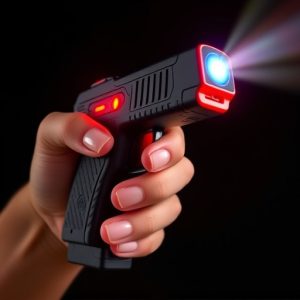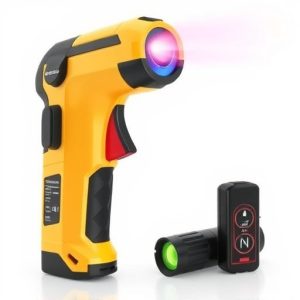Illuminating Safety: A Comprehensive Guide to Stun Guns with Alarm and Light Features
Stun guns have evolved into sophisticated self-defense tools equipped with alarms, lights, and safe…….
Stun guns have evolved into sophisticated self-defense tools equipped with alarms, lights, and safety features that enhance their deterrent capabilities. These devices emit high-voltage electrical charges to incapacitate attackers while simultaneously producing loud alarms to startle and disorient potential assailants. The built-in LED lights or strobe functions offer improved visibility in low light conditions and can temporarily blind an aggressor, contributing to a user's ability to defend themselves until help arrives. The strategic combination of auditory and visual features in stun guns with alarm and lights systems makes them a reliable and effective personal security solution for a range of situations. It's crucial for users to be knowledgeable about the legal framework regarding these devices, ensuring they are used responsibly within the bounds of local laws and regulations, which can vary significantly by jurisdiction. Proper training is essential to maximize the utility of stun guns with alarm and lights in self-defense scenarios, making them a key development in personal defense technology.
Stun guns have evolved beyond mere electrified devices, now incorporating advanced features such as integrated alarms and strobe lights, enhancing personal safety and deterrence. This article delves into the multifaceted role of these innovations in self-defense mechanisms. We’ll explore their mechanism, legal implications, and how to choose the optimal stun gun with alarm and lights for your security needs. Additionally, we’ll shed light on the functionality of strobe lights within stun guns and why they are a critical component in disorienting potential attackers. Understanding these aspects is crucial for anyone considering stun guns as part of their personal safety strategy.
Understanding Stun Guns with Alarm and Lights Features
Stun guns have evolved from mere electroshock devices to sophisticated self-defense tools that include additional safety features such as alarms and lights. These enhanced stun guns are designed to provide users with a more effective and visible deterrent against potential attackers. The integration of an alarm system is particularly beneficial; it emits a loud, disorienting sound that can draw attention and deter assailants before any physical contact is made. This auditory warning signal acts as a psychological defense mechanism, often causing aggressors to retreat due to the surprise and embarrassment of being exposed in a public setting.
Moreover, the inclusion of a bright LED light or strobe function serves a dual purpose. Firstly, it illuminates the environment, which is crucial for improving visibility during confrontations that may occur in low-light conditions. Secondly, the flashing strobe can be used as an incapacitating tool, as sudden bright lights can cause temporary disorientation or blindness, further enhancing personal safety. The combination of these features in stun guns with alarm and lights offers users a reliable means to protect themselves in a variety of scenarios. It’s the strategic integration of sound and light that makes these advanced stun guns a prudent choice for individuals seeking enhanced personal security options.
The Mechanism Behind Stun Guns: Safety and Deterrence
Stun guns are defensive tools designed to incapacitate an attacker by delivering a high-voltage, low-ampere electric current, causing neuromuscular incapacitation. These devices are often equipped with additional safety features such as alarms and lights, enhancing their functionality and deterrence potential. The mechanism behind stun guns involves two primary electrodes separated by an insulating barrier; when activated, the device releases a charge that jumps the gap between these electrodes. The electrical discharge disrupts the normal functioning of the victim’s muscular system, leading to temporary paralysis and confusion. This effect is typically short-lived, allowing for an opportunity to escape or defend oneself until professional help arrives.
The integration of alarms and lights in stun guns serves a dual purpose: firstly, they act as a psychological deterrent, signaling to potential assailants that the user is equipped with a defense mechanism; secondly, they provide an audible and visual alert for anyone within range, aiding in personal safety. The alarm emits a loud noise designed to disorient an attacker or attract attention from bystanders. Meanwhile, the lights can momentarily blind an aggressor, further enhancing the user’s defensive capabilities. These features underscore the role of stun guns as both a protective tool and a device that can deter potential threats before escalation occurs. Users should be well-versed in the legal implications and proper usage of stun guns to ensure safety for themselves and others.
Legal Considerations for Owning Stun Guns with Alarm and Lights
When considering the acquisition and ownership of stun guns equipped with alarms and lights, it is imperative to understand the varying legal landscapes across different jurisdictions. These devices, often designed for personal defense, are not universally permitted. Prospective owners must navigate state and local laws to ascertain the legality of possessing a stun gun with an alarm and lighting capabilities. In some regions, additional restrictions may apply, such as age limitations or requirements for registration and training. The inclusion of audible alarms and bright lights enhances the device’s deterrent factor, but it also necessitates a more thorough examination of regulations due to these features potentially classifying the stun gun as a more sophisticated defensive tool. Users should be aware that laws change frequently, and it is their responsibility to stay informed about the current legal status of such devices where they reside or intend to carry them. Compliance with these legal considerations is crucial for responsible ownership and use. Understanding the local statutes regarding self-defense tools like stun guns with alarm and lights will ensure that users operate within the bounds of the law, avoiding potential legal repercussions.
Selecting the Right Stun Gun with Alarm and Lights for Your Needs
When considering a stun gun with an alarm and lights for personal safety, it’s crucial to assess your specific needs and circumstances. A stun gun with an integrated alarm can serve as a potent deterrent, emitting a high-decibel sound capable of disorienting an attacker while also drawing attention to your location. The bright lights accompanying the device can temporarily blind an assailant, providing you with a critical advantage during an encounter. Factors such as the strength of the electrical charge, the volume and range of the alarm, and the intensity of the strobe light should be evaluated based on your comfort, legal restrictions in your area, and the level of defense you require. Additionally, the design and ergonomics of the stun gun, including its grip and ease of use, are important for ensuring that you can effectively deploy it if necessary. It’s also wise to consider the durability and reliability of the device, as well as any additional safety features it may have, such as a safety switch to prevent accidental discharges. By carefully selecting a stun gun with an alarm and lights that matches your individual needs and circumstances, you can enhance your personal defense strategy effectively. Remember to adhere to local laws and regulations regarding self-defense tools before purchasing or using a stun gun for protection.
Demystifying the Strobe Light Functionality in Stun Guns
Stun guns have evolved over the years, incorporating various features to enhance their effectiveness as a personal defense tool. Among these advancements are models equipped with an alarm and lights system, which significantly amplifies their deterrent capabilities. The strobe light functionality within these devices serves a dual purpose: it can disorient an assailant and also act as a visual signal for attention or distress. When activated, the strobe light emits a rapid series of bright flashes that can temporarily impair an attacker’s vision, causing confusion and disarray. This feature complements the primary stun function by providing a non-lethal means to incapacitate an aggressor from a distance. Additionally, the high-intensity light can be used as a signaling device in emergency situations, making it easier for bystanders or first responders to locate the individual in need of assistance. Stun guns with alarm and lights thus offer a comprehensive safety package, ensuring that users have both an electrical defense mechanism and a visual distress signal at their disposal. It’s crucial for users to understand how to effectively deploy these features in various situations, as they can be pivotal in self-defense scenarios. Understanding the legal implications of using such devices is also imperative, as stun gun laws vary by jurisdiction and misuse can lead to legal consequences.


